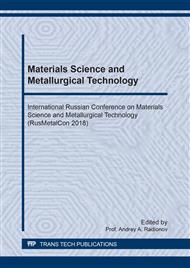p.493
p.500
p.506
p.512
p.517
p.523
p.528
p.535
p.541
Mathematical Model of the Reduction of Metals from Complex Polymetallic Types of Ore Applicable to the Electron Mechanism
Abstract:
The mathematical description of the electron mechanism of reduction of metals from complex polymetallic types of ore has been suggested. The description of the mechanism was based on diffusion and thermal processes occurring in the phases of a reducing agent and an oxide, and chemical reactions on the surface of a phase boundary. The effect of the major physics-chemical parameters on the rate of formation and movement of the reducing vacancies was considered. The obtained model allows calculation of the process of metal reduction from the bulk of a complex oxide by using the approach of the electron mechanism, which considers the process of reduction not as the interaction of the reducing agent with molecule of the metal oxide, but as the interaction with the oxygen anion of a crystal lattice.
Info:
Periodical:
Pages:
517-522
Citation:
Online since:
February 2019
Authors:
Keywords:
Price:
Сopyright:
© 2019 Trans Tech Publications Ltd. All Rights Reserved
Share:
Citation:


